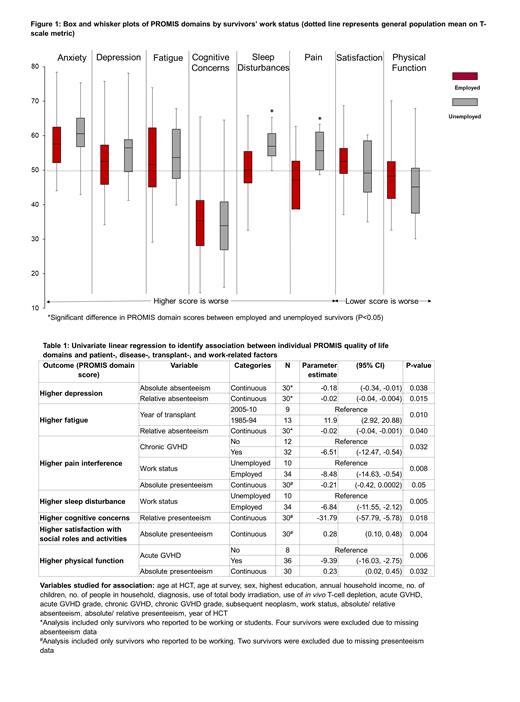Abstract
Background: Post-allogeneic hematopoietic cell transplant (HCT) work status is an important indicator of survivors' health recovery and social and economic well-being. However, current literature lacks data on work status, missed time at work, work performance, and quality of life (QOL) of long-term survivors of childhood HCT.
Methods: A cross-sectional web-based survey study of ≥1-year survivors of childhood allogeneic HCT (performed between 1985-2010 at Children's Wisconsin, Milwaukee, WI) who were <18 years of age at HCT and ≥18 years of age at their most recent assessment. Eligible survivors were identified using the Center for International Blood and Marrow Transplant Research database and contacted by email and/or mail. Validated patient reported outcomes measures, the World Health Organization Health and Work Performance Questionnaire (HPQ) and the National Institutes of Health Patient Reported Outcomes Measurement Information System (PROMIS) were used to capture work and QOL data, respectively. Using HPQ responses, working survivors' work absenteeism and presenteeism scores were calculated. Absenteeism scores were also calculated for the survivors who reported to be students. Absolute absenteeism was defined as 4*(no. of hours expected at work or school) - no. of hours actually worked or attended school. Relative absenteeism was defined as absolute absenteeism score/ 4*(no. of hours expected at work or school). Absolute presenteeism was defined as 10*(self-reported work performance in last 4 weeks). Relative presenteeism was defined as self-reported work performance in last 4 weeks / self-reported performance of co-workers. Higher absenteeism and presenteeism scores indicated higher missed time at work or school and better work performance, respectively. PROMIS domains were scored on a T-score metric with a mean score of reference population at 50 and standard deviation of 10. The primary outcome was individual PROMIS domain score as a continuous variable. Univariate linear regression was performed to study factors associated with increase in PROMIS domain scores. For negatively worded domains (anxiety, depression, fatigue, sleep disturbance, cognitive concerns, pain interference), higher score was considered worse and for positively worded domains (physical function, satisfaction with social roles and activities), lower score was considered worse. Student survivors were considered employed in the analysis. P-value <0.05 was considered statistically significant.
Results: Out of 99 allogeneic HCT recipients who met the selection criteria, 47 initiated the survey and 44 completed it (44% response rate). At the time of survey, 73% (n=32) of the respondents were working, 23% (n=10) were unemployed, and 4% (n=2) were students. Median age at HCT and survey were 11.1 years (interquartile range [IQR] 7.0-13.5) and 30.0 years (IQR 26.5-34.0), respectively. Median follow-up from HCT was 22 years (range 9-32). Fifty two percent were females and 75% received HCT for malignant diseases (acute lymphoblastic leukemia 45%). Compared to unemployed survivors, employed survivors reported less pain interference and sleep disturbance (Figure 1). History of acute graft vs. host disease (GVHD) was associated with worse physical function. Median absolute absenteeism and presenteeism scores were 0 hours (IQR [-1.5]-16) and 83 (IQR 73-92), respectively. Higher absolute presenteeism was associated with less pain interference and more satisfaction with social roles and activities and physical function. Higher relative presenteeism was associated with less cognitive concerns. Higher absolute absenteeism was associated with less depression and higher relative absenteeism with less fatigue (Table 1).
Conclusions: Nearly a quarter of the survivors reported being unemployed at the time of the survey. Significant associations between survivors' work status, work performance, and QOL were identified. Our findings provide an important insight on the implications of work outcomes on HCT survivors' physical, mental, and social health and emphasizes the importance of routine longitudinal assessment of work status, performance and QOL in this population. These results also have the potential to help develop effective communication strategies with employers to balance work expectations of survivors in order to achieve better work productivity and in turn, good QOL.
Bhatt: Johnson & Johnson: Divested equity in a private or publicly-traded company in the past 24 months; Moderna, Inc.: Divested equity in a private or publicly-traded company in the past 24 months; Pfizer Inc.: Divested equity in a private or publicly-traded company in the past 24 months; Rite Aid Corporation: Divested equity in a private or publicly-traded company in the past 24 months. Phelan: Amgen Pharmaceuticals: Research Funding. Shaw: mallinkrodt: Other: payments; Orca bio: Consultancy.


This feature is available to Subscribers Only
Sign In or Create an Account Close Modal